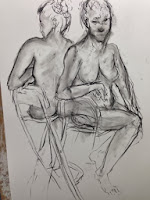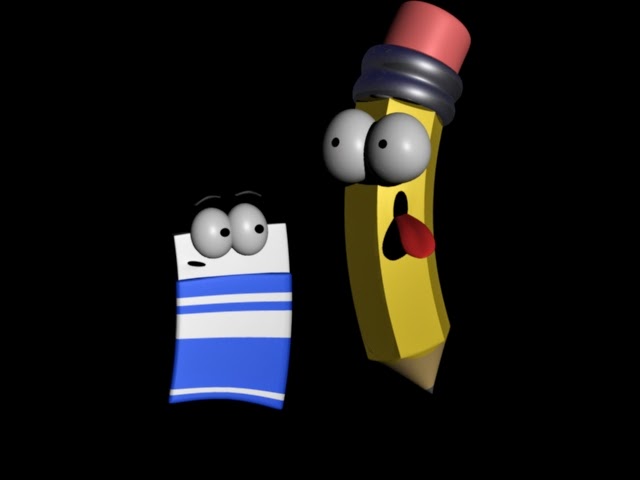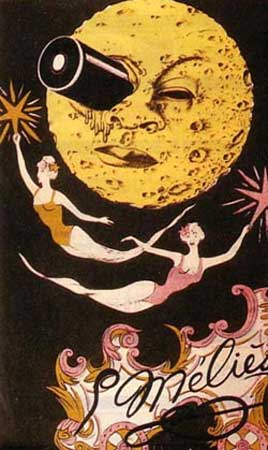First time doing life drawing, and it was a very helpful experience. A mixture of long a short drawing sessions.
Thursday 31 October 2013
Tuesday 29 October 2013
Saturday 26 October 2013
CG Artists Toolkit Drawing: Still Life 2
Worked from this structure. I quickly sketched out the basic shape and then moved onto using the paint. I tried to make it as interesting as possible, I would let the colours bleed to blend and create some shading. Afterwards I just let the paint run. I'm quite please with the result:
Friday 25 October 2013
Thursday 24 October 2013
Cinematic Spaces Thumbnails: 65-76
Here I've selected my favorite 4 thumbnails from the past few sets. 65-68 is a combination of the crystals and lava described in the first extract (which I sketched out separately first).
I can see from this set my favorites emerging to be used as my final pieces. However, as much as I like no.69; I'm not entirely sure it will alongside such an impacting orange mix and green. An experiment would be for the best before I set on that if I want to use it as a final image.
Sunday 20 October 2013
Cinematic Spaces: Thumbnails 33-64
In the second extract I was provided from "A Journey to the Center of the Earth" the find themselves at the shores of a never ending ocean.
"A vast sheet of water, the commencement of a lake or am ocean, spread far away beyond the range of the eye..." "The deeply indented shore was lined with a breadth of fine shining sand, softly lapped by the waves, and strewn with the small shells which had inhabited by the first of created beings." - Chapter XXX
My favourite from this set is no.35 which I referenced a sea cove, for the sunlight through the open gaps of the cove I reduced the opacity and blurred it to smooth my strokes, and no.37 with the waves lightly hitting the shore.
"A vast sheet of water, the commencement of a lake or am ocean, spread far away beyond the range of the eye..." "The deeply indented shore was lined with a breadth of fine shining sand, softly lapped by the waves, and strewn with the small shells which had inhabited by the first of created beings." - Chapter XXX
In the next part of my second extract the location changes to a forest of over sized mushrooms. I've never actually draw mushrooms properly before, so I thought it would be useful to do a quick study on various ones. This took less than 5 minutes to do, so it was very beneficial without being time consuming.
I therefore attempted to put these into practice in my thumbnails:
I enjoyed trying different views for each thumbnail and my personal favorite from this set would be no.50.
In other sketches I have included the over sized fern tree and over foliage as described in the extract.
Wednesday 16 October 2013
CG Artists Toolkit: Still Life 1
Base structure for our drawings today.
Tuesday 15 October 2013
Cinematic Spaces Film Review: Metropolis
Metropolis is a 1927 German expressionist epic science-fiction film directed by Fritz Lang. Made in Germany during the Weimar Period, Metropolis is set in a futuristic urban dystopia, and follows the attempts of Freder, the wealthy son of the city's ruler, and Maria, whose background is not fully explained in the film, to overcome the vast gulf separating the classicist nature of their city.
The visuals in this film is absolutely breath taking, especially considering the time it was created in. This amazing city of the future, a place of towering skyscrapers and aerial expressways and the catacombs running under this beautiful city. Fully contrasting between the upper and working class.
"With its immense sets and stark lighting, the workers' city is a credible image of hell, while the overground landscapes were a seminal influence on all subsequent science fiction" (Pierce, 2003).
Fig 1 Metropolis (1927)
Metropolis has the themes of human struggle and religion, the pampered citizens who live in luxury; as we see in the beginning with Freder frolicking in the garden with the women,
oblivious to the lower class working 10 hour shifts to keep the machine
running in the depths (who we see lined up like cattle at the beginning of the episode at the gates to the machines).
“Maria longs for a
messianic figure who can find a middle way between the head and the heart,
the bosses and the workers: he will be the Mediator” (Bradshaw,2010).
Maria wants to unite the bosses and
workers together, she preaches to the workers in the catacombs where she stands
in front of some crosses which are linked to Christianity.
Fig 2 Metropolis (1927)
"With its immense sets and stark lighting, the workers' city is a credible image of hell, while the overground landscapes were a seminal influence on all subsequent science fiction" (Pierce, 2003).
Fig 3 Metropolis (1927)
Review Biblography:
Quotes:
Bradshaw. P.(2010) Metropolis At: http://www.theguardian.com/film/2010/sep/09/metropolis-restored-film-review (Accessed on 14.10.13)
Pierce. N.(2003) Metropolis At: http://www.bbc.co.uk/films/2003/01/06/metropolis_1927_review.shtml (Accessed on 14.10.13)
Pictures:
Fig 1 Metropolis (1927) [Poster] At: http://upload.wikimedia.org/wikipedia/en/thumb/0/06/Metropolisposter.jpg/220px-Metropolisposter.jpg (Accessed on 14.10.13)
Fig 2 Metropolis (1927) From: Metropolis. Directed by: Fritz Lang [Film still], Weimar Republic, At: http://blogs.commercialappeal.com/the_bloodshot_eye/metropolis/metroposky.jpg (Accessed on 14.10.13)
Fig 3 Metropolis (1927) From: Metropolis. Directed by: Fritz Lang [Film still], Weimar Republic, At: http://blogs.commercialappeal.com/the_bloodshot_eye/metropolis/metropolrobot.jpg (Accessed on 14.10.13)
Saturday 12 October 2013
Cinematic Spaces: Thumbnails 17-32
From the first extract, focusing on the lava. I personally like no.8 with the lava pouring from above.
I tried doing an underneath shot for no.2 with the lava dripping from above, I liked the idea but I'm unsure whether or not it worked.
Cinematic Spaces: Extract 1 Influence maps
The first extract I was given from "A Journey to the Center of the Earth" by Jules Verne described areas of lava encrusted walls and clusters of crystals. I automatically thought of things such as the Fire Temple from the Legend of Zelda series, a very typical image but inspired me a lot with my tumbnails. For the crystals I viewed stills from the Final Fantasy series, World or Warcraft etc.

Thursday 10 October 2013
Wednesday 9 October 2013
Cinematic Spaces Film Review: The Cabinet of Dr. Caligari
In The Cabinet of Dr. Caligari, Dr. Caligari exhibits a somnambulist (sleepwalker) named Cesare ,who predicts the future. It is here that the main character (Francis) meets the "villain" of this story. After his best friend's death is predicted, and comes to pass. Mysteries begin to unravel and plot twists unfold in Holstenwall.
Fig 1 The Cabinet of Dr. Caligari (1921)
The Cabinet of Dr. Caligari 1920, directed by Robert Weine, is notably one of the most influential films of German Expressionism not only during the silent era, but in films today. It was this story that became the base of all thriller films.
It's sets are so captivating for its simplicity and uniqueness – something that we can see someone such as Tim Burton today being heavily influenced by. However, the sets weren't just created to give off a creepy feeling to film in general, it all represented something. As Roger Ebert (2009) states; “He (Robert Weine) is making a film of delusions and deceptive appearances, about madmen and murder, and his characters exist at right angles to reality. None of them can quite be believed, nor can they believe one another.” Its unique abstract style for the environment was created perfectly to reflect on the true nature of this film.
It is important to keep such ideas like this in mind whilst watching The Cabinet of Dr. Caligari especially this particular note by Total Film (2000); "Angular sets, twisted perspectives and off-centre houses convey the disturbed minds of the central characters..." The "disturbed minds of the central characters" becomes oh so apparent by the end of the film. The environments becoming the true personification of all of the character's madness.
The filmmakers use various colored filters to create the effect of a color movie. Tinted shades of sepia tone, blue, and purple add narrative depth to queasy episodes of altered mental states.
Finally, the ending to this film has been credited to have introduced the "twist ending", the first of its kind in cinema. By revealing such a shocking turn of events, Weine was able to wrap up the film perfectly in both Francis' madness and reality. With a story and set that compliments each other so well, it is indeed a title which deserves it's reputation.
"With its unusual look and neatly folding method of storytelling “The Cabinet of Dr. Caligari” is an artistically uninhibited silent horror film that still sends chills." - Cole Smithey (2011)
Fig 4 The Cabinet of Dr. Caligari (1920)
Review Biblography:
Quotes:
Ebert, Roger (2009) Great Movie: The Cabinet of Dr. Caligari, At: http://www.rogerebert.com/reviews/great-movie-the-cabinet-of-dr-caligari-1920 (Accessed on 04.10.13)
Smithey, Cole (2011) The Cabinet of Dr. Caligari - Classic Film Pick, At: http://www.colesmithey.com/capsules/2011/10/the-cabinet-of-dr-caligari.html (Accessed on 04.10.13)
Total Film (2000) The Cabinet of Dr. Caligari, At: http://www.totalfilm.com/reviews/dvd/the-cabinet-of-dr-caligari (Accessed on 04.10.13)
Total Film (2000) The Cabinet of Dr. Caligari, At: http://www.totalfilm.com/reviews/dvd/the-cabinet-of-dr-caligari (Accessed on 04.10.13)
Pictures:
Fig 1 The Cabinet of Dr. Caligari 1921 [Poster] At: http://en.m.wikipedia.org/wiki/File:CABINETOFDRCALIGARI-poster.jpg (Accessed on 03.10.13)
Fig 2 The Cabinet of Dr. Caligari (1920) From: The Cabinet of Dr. Caligari. Directed by: Robert Weine, [Film still], Weimar Republic, At: http://en.m.wikipedia.org/wiki/File:CABINET_DES_DR_CALIGARI_01.jpg (Accessed on 03.10.13)
Fig 3 The Cabinet of Dr. Caligari (1920) From: The Cabinet of Dr. Caligari. Directed by: Robert Weine, [Film still], Weimar Republic, At: http://blackholereviews.blogspot.co.uk/2012/05/cabinet-of-dr-caligari-1920-fundamental.html?m=1 (Accessed on 03.10.13)
Fig 4 The Cabinet of Dr. Caligari (1920) From: The Cabinet of Dr. Caligari. Directed by: Robert Weine, [Film still], Weimar Republic, At: http://defensiveweaponofgun.wordpress.com (Accessed on 03.10.13)
Tuesday 1 October 2013
Cinematic Spaces Film Review: Le Voyage dans la Lune 1902
Le Voyage dans la Lune is a 1902 French silent film directed by Georges Méliès. It follows a group of
astronomers who travel to the moon in a cannon-propelled spaceship, explore the
moon's surface, escape from an underground group of Selenites (lunar
inhabitants), and return in a splashdown to Earth with a captive Selenite in
tow.
Fig 1
Le Voyage dans la Lune was the first science fiction story, running only for 14 minutes but considered as an epic at the time. The plot was inspired by Jules Verne's "From the Earth to the Moon (1865)" and H.G.Wells' "First Men in the Moon (1901)" and was a light-hearted satire that criticized the conservative scientific community of its time.
The theatrical backdrops that were used for the film Le Voyage dans la Lune gave it a very
pleasing picture-book feeling overall. Sean Axmaker writes; "...a work of pure, playful imagination...brought to life with intricate, hand-painted sets..."(1) It was bizarre, yet interesting to see
what the minds back in the early 1900s thought was on the moon. When the
shuttle first lands we are presented with a scene which includes a
crater-filled ground and also spiky rocks which are of course their imagination
to fill the space seeing as they've never stepped foot on the moon at the time.
To further this point, from Fig 2, we can see the underground cave filled with mushrooms which
also a very imaginative idea at the time. It again was interesting to see that
they believe something on their own planet would also be on the moon – again
due to the lack of knowledge they had at the time and therefore needed to
create something that would stick with the audience, so therefore ended up
using something recognizable like the overgrown mushrooms.
An important point to note as well, as written by Jeffrey M. Anderson, is that; "...Méliès saw his frame as two-dimensional, like a painting."(2) This again supports the collective view that Les Voyage dans la Lune was very storybook-like. Instead of utilising the full depth of each frame, Méliès concentrated the movements from left-to-right and vice versa.
Méliès not only had beautiful sets created, but also skillfully included special effects that brought out the scenes even more. From the alien's being vanquished to smoke to the industrial chimneys back on earth (Fig 4) - which were painted and Méliès was able to make them puff out real smoke. The results of all these special-effects, which Josh Larson from Laser on Film ties up nicely as; "...evocative of the movie's era. Just as the journey of the title has a sense of playful discover, the film's first viewers must have felt the thrill of something new. "(3)
Review Bibliography
Quotes:
Sean Axmaker (1): http://www.seanax.com/2012/04/11/cinema-landmark-a-trip-to-the-moon-restored/
Jeffrey M. Anderson (2): http://www.combustiblecelluloid.com/classic/trip_to_the_moon.shtml
Josh Larson (3): http://www.larsenonfilm.com/a-trip-to-the-moon
Images:
Fig 1 Movie poster: http://www.weirdwildrealm.com/f-melies4.html
Fig 2 Film still: http///filmabinitio.blogspot.com/2010/09/1910-wonderful-wizard-of-oz-otis-turner.html
Fig 1 Movie poster: http://www.weirdwildrealm.com/f-melies4.html
Fig 2 Film still: http///filmabinitio.blogspot.com/2010/09/1910-wonderful-wizard-of-oz-otis-turner.html
Fig 3 Film still: http://drnorth.files.wordpress.com/2010/06/le-voyage-dans-la-lune-georges-melies-1902-tableau-8c.png?w=584&h=438
Fig 4 Film still: http://lifevsfilm.com/2013/05/21/voyage-dans-la-lune/
Journey to the Center of the Earth Research

A Journey to the Center of the Earth is a classic1864 science fiction novel by Jules Verne.The
story involves German professor Otto Lidenbrock who believes there are volcanic
tubes going toward the center of the Earth.He, his nephew Axel, and their guide Hans
descend into the Icelandic volcano Snæfellsjökull, encountering many adventures,
including prehistoric animals and natural hazards, before eventually coming to
the surface again in southern Italy, at the Stromboli volcano. In the mid-19th
century, during Verne's lifetime,exploration to unknown lands was in
vogue.
During this period, the interior of Africa, the geographical and magnetic poles, and much of Central and
South America were little known by Europeans. Well known explorers such as
Sir Richard Burton and Henry Morton Stanley and David Livingston were
exploring above the earth's surface as their fictional counterparts Professor
Hardwigg and Harry were exploring below.
Also, Charles Darwin was gaining
attention for his theory of evolution; this is touched on by Verne in this novel.
New frontiers were opening while "new ideas about the planet's core,prehistoric
man, dinosaurs, and early life on earth battled religious intolerance
and Barnum-like hoaxes" (Afterword 292). The Afterword of this Signet
Classic edition explains that Verne "was able to adapt nearly every
important element in the story's action from contemporary,intellectual, literary, scientific, and geographical thought"
(291). The world during Verne's lifetime was full of new ideas and was exploding with new knowledge. Verne
captures that spirit in Journey to the Center of the Earth
.
CG Artist Toolkit: Photoshop
Done in class today. Selected my 4 personal favourites from my first set of thumbnails and tried different colour variants.
I also used Adobe Kuler to select the hues and complimentary colours (more noticeable in 1 (red/orange with slight green tints) and 2 (pink/purple with yellow).
Subscribe to:
Posts (Atom)












































